I Dig Sports
Niroshan Dickwella's 61 gives Sri Lanka first-innings honours
Published in
Cricket
Thursday, 15 August 2019 23:10
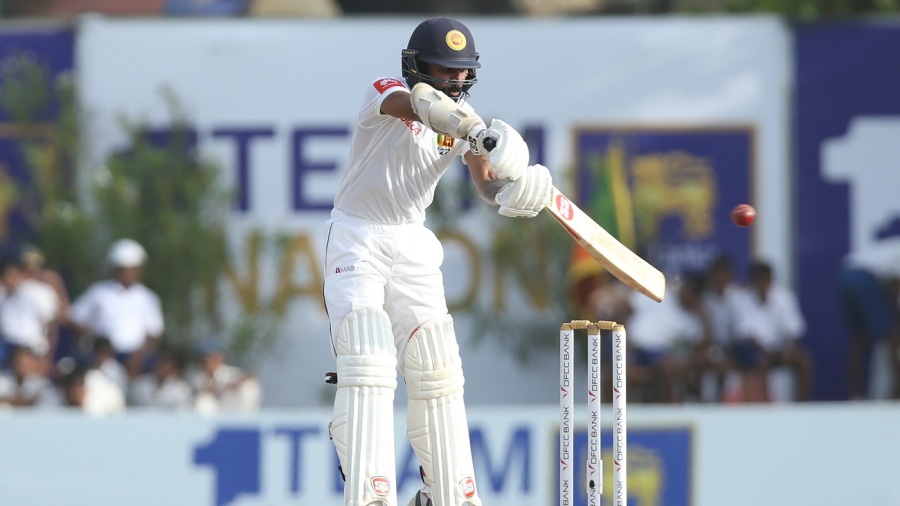
Innings Sri Lanka 267 (Dickwella 61, Lakmal 40, Patel 5-89) lead New Zealand 249 by 18 runs
After being ignored for the 2019 World Cup and then missing the cut for the ODI series at home against Bangladesh, Niroshan Dickwella proved his worth to the Test side with a calculated 61, ushering Sri Lanka to an 18-run first-innings lead in Galle. Resuming on an overnight 227 for 7, Sri Lanka added 40 to their tally before Trent Boult and Will Somerville took the remaining three wickets about an hour before lunch on the third day.
New Zealand took the new ball immediately and Boult pushed the batsmen back with a barrage of short balls. While Suranga Lakmal was struck flush on his right elbow, Lasith Embuldeniya copped a glancing blow on the helmet. Two balls after being hit, Lakmal stood deep in the crease to a ball that wasn't short enough and wound up dragging it back onto the stumps for 40, snapping an 81-run eighth-wicket stand.
At the other end, Dickwella was more competent against the short stuff, often rolling his wrists to keep the ball down. He reached his half-century in the 88th over when he dinked Ajaz Patel to the leg side for a single. Four overs later, Somerville dangled one up outside off - wider than a set of stumps outside off - and had Dickwella slapping a catch to Kane Williamson at short cover for 61 off 109 balls. Somerville then pinned Embuldeniya in front to end the innings and leave the game fascinatingly poised with the Galle track yet to deteriorate.
Tagged under
Gruden 'optimistic' on AB's progress after drills
Published in
Breaking News
Thursday, 15 August 2019 22:48
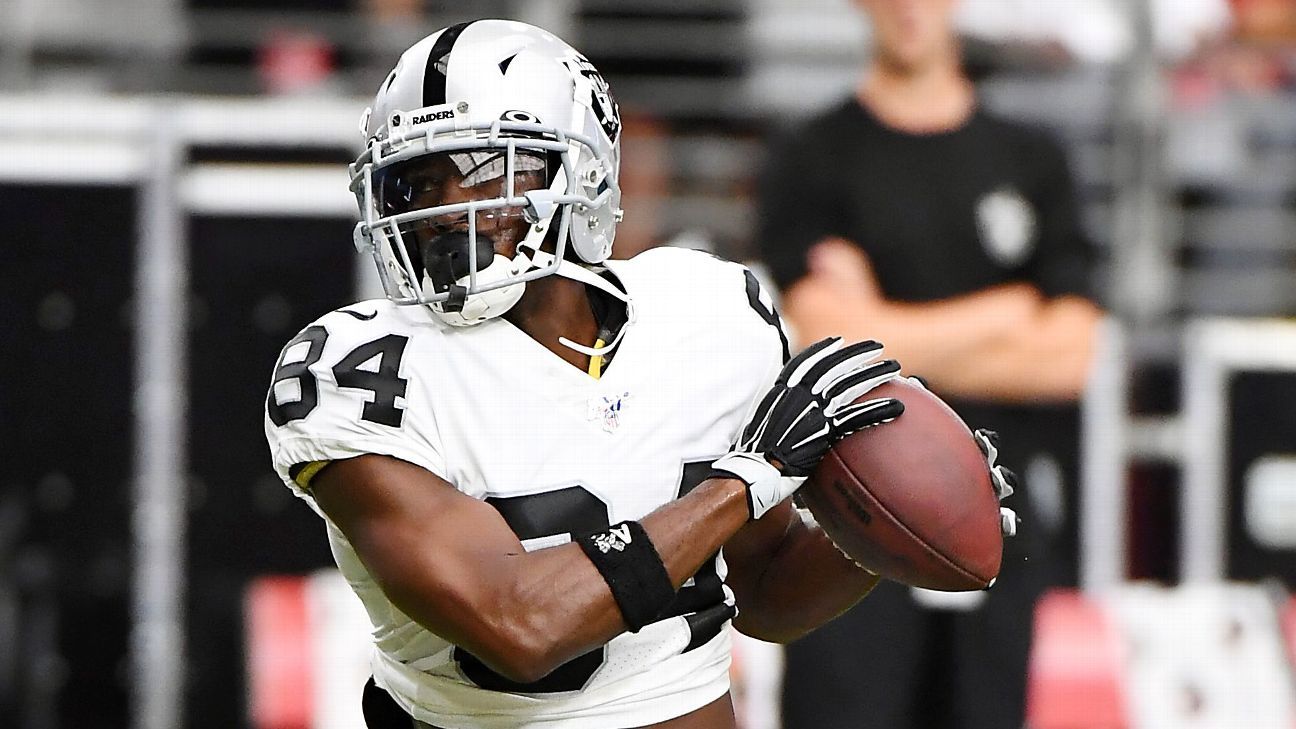
The show Antonio Brown put on in running routes and catching passes from Derek Carr on the State Farm Stadium grass before the Oakland Raiders' 33-26 preseason defeat of the Arizona Cardinals on Thursday night has coach Jon Gruden hopeful.
As in, Gruden hopes Brown practices with the Raiders before the team breaks camp in Napa, California, on Monday.
"I'm not going to say anything else, but I'm very optimistic after what I saw tonight," Gruden said after the game, in which Oakland built a 26-0 lead, with its defensive starters playing four series against No. 1 draft pick Kyler Murray.
"Hell yeah, it was encouraging. It was great to have him back," Gruden added of Brown. "You know, it's been a strange, strange couple weeks, with frostbite and the helmet grievance. Can't say that that's common, at least in my history in this league. But we've weathered the storm."
Brown had been away from the team for two weeks after starting camp on the non-football injury list before participating in one pre-practice walkthrough July 28, being limited July 30 and then leaving the field early.
Carr also said he was encouraged.
"It was kind of right where we left off," Carr said. "He's such a good player, and we've spent so much time together that I knew when he came back it'd be just like he never left. He came in. You see him chatting it up with everybody on the sideline. He's our teammate. We love him. That's our brother and we're just happy that he's here so we can put our arms around him and head forward."
Brown was away seeking treatment on the soles of his feet, which he injured in a cryotherapy mishap in France early last month. He told ESPN's Lisa Salters the injury occurred because he wore only socks. Therapy included laser treatments, said Brown's agent Drew Rosenhaus, who added that the injury was the main reason Brown was absent from camp and not so much his grievance against the NFL as Brown sought to be able wear his 10-year-old Schutt Air Advantage helmet, the only helmet he has worn in his professional career.
Brown lost the grievance Monday and returned to Napa on Tuesday.
Gruden would not say what helmet Brown was wearing during warm-ups.
"I'm not talking about it anymore," Gruden said. "It was a legal, certified helmet, you know? Somebody approved it, or he wouldn't have worn it.
"It's great to see him out there with his teammates. He appears to be in great spirits and he appears like he's ready to get going here, so that's Antonio Brown. We're excited about him. I'm excited about him. I could care less what anybody else says, I'm excited."
The Raiders are scheduled to hold practice in Napa on Saturday and Sunday before breaking camp Monday, then "host" the Green Bay Packers in their penultimate preseason game at Winnipeg, Manitoba, on Thursday.
Tagged under
Agent: Cousins has torn ACL; may miss season
Published in
Breaking News
Thursday, 15 August 2019 15:08
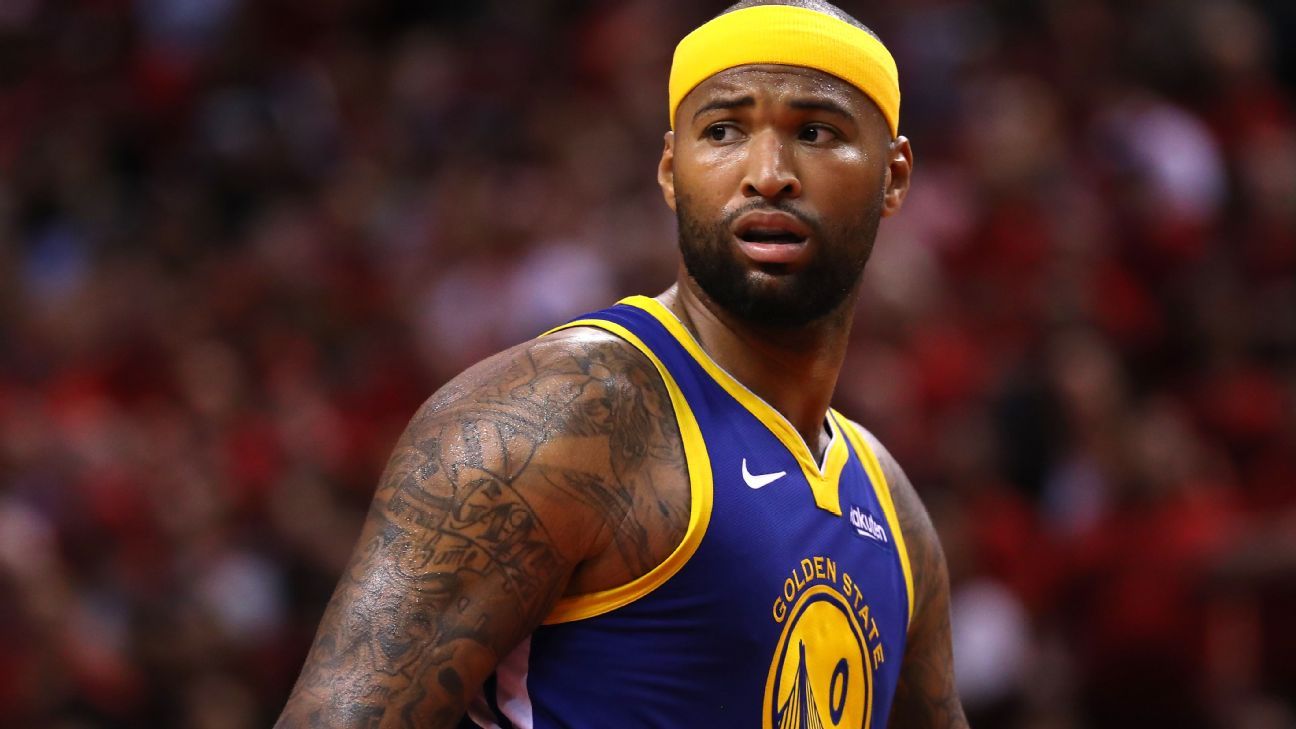
Los Angeles Lakers center DeMarcus Cousins has suffered a torn ACL in his left knee, agent Jeff Schwartz of Excel Sports told ESPN, putting his availability for next season in jeopardy.
There is no timeline for surgery.
Cousins' visit to team physicians in Los Angeles on Thursday confirmed the diagnosis, which constitutes a third serious leg injury in the past year and a half.
"It's no joke when you get injured," Lakers teammate Kyle Kuzma said after USA Basketball's practice at the Lakers' facility on Thursday. "This is our livelihood and it's something that we love to do. It's super-unfortunate for a guy like DeMarcus because you just tell how much he loves basketball through all of these injuries -- he's fought back and tried to get back as early as possible.
"That's kind of how the ball goes sometimes. You just never really know. ... He was going to be a big part of what we're going to do."
Cousins, a four-time All-Star, already had his mobility compromised with a left Achilles tear in January 2018 and a quadriceps tear in April.
Cousins, 29, was working out in Las Vegas on Monday when he had to leave the court.
1:12
Kuzma saddened by Cousins' ACL injury
Kyle Kuzma is saddened by DeMarcus Cousins' ACL injury and says it has made him appreciate his ability to play the game.
The loss of Cousins could prompt All-Star forward Anthony Davis to play more center for the Lakers this season, with JaVale McGee playing more minutes at the backup spot.
Cousins signed a one-year, $3.5 million contract with the Lakers in July. He was expected to be part of a team expected to be among the NBA's elite this season. In his nine NBA seasons, Cousins has averaged 21.2 points and 10.9 rebounds a game.
During his one-year deal with Golden State last season he spent most of his time rehabilitating the Achilles injury before playing 30 regular-season games. He suffered the quad injury in Game 2 of a first-round playoff series. He returned in Game 1 of the NBA Finals against Toronto.
Tagged under
Harper: Walk-off GS one of my 'coolest moments'
Published in
Breaking News
Thursday, 15 August 2019 21:32

PHILADELPHIA -- Bryce Harper knows everyone in the dugout and ballpark expects him to get clutch hits in moments just like this.
Boy, he crushed it.
Harper blasted a grand slam with one out in the ninth inning, capping a six-run rally that sent the Philadelphia Phillies over the Chicago Cubs 7-5 Thursday night for a three-game sweep.
Harper delivered his biggest hit yet in his first season after signing a $330 million, 13-year contract with the Phillies, celebrating while running around the bases and then getting mobbed by teammates at the plate.
"That was sick. Wow, I don't even know. I mean, that was awesome. Oh my gosh," he said.
Harper added of his walk-off shot: "Besides winning the division and getting to the playoffs, that was one of the coolest moments I've ever had in my life."
Cubs starter Yu Darvish struck out 10, silencing Philadelphia's bats for seven innings a night after the Phillies scored 11 runs in former manager Charlie Manuel's debut as hitting coach.
But the Phillies rallied against Chicago's bullpen and moved within one game of the Cubs for the second wild-card spot in the National League.
Pinch hitter Brad Miller chased Rowan Wick with an RBI single in the ninth that cut it to 5-2, and Roman Quinn greeted Pedro Strop with an RBI single to make it a two-run game. Strop (2-5) hit Rhys Hoskins to load the bases with one out.
Derek Holland entered to face Harper and got ahead 0-2 in the count. Harper fouled off a 2-2 pitch before launching his 25th homer way out to right.
"Before I went to the plate, I touched my heart and I was thinking to myself: 'Why am I not jittery? Why am I not excited?' But that's just how I am," Harper said. "I go up there and each at-bat is the same. I don't think about bases loaded. I try to get a pitch I can drive and hopefully good things happen. I love those moments. I love those opportunities. I think it helped me a lot from a young age going through those emotions and having those opportunities at 8, 9, 10 years old in big-time games going to different states and cities playing for a lot of teams."
"I just love it. It's a lot of fun. These fans do expect that and I expect to do that for them on a nightly basis -- and if I don't, they'll let me know and I like that, too," he said.
Harper now has six career walk-off home runs, the second-most since he made his major league debut in 2012, behind Josh Donaldson, who has seven, according to ESPN Stats & Information research.
"I think everyone who watches baseball expects him to do that every time he's up," Phillies starter Drew Smyly said. "He's fun to watch."
Harper has seven homers and 15 RBIs in the past 12 games.
Ranger Suarez (4-1) tossed two scoreless innings to earn the win.
Anthony Rizzo, batting leadoff after the original lineup had him in his usual cleanup spot, gave the Cubs a 1-0 lead in the third when he hit his 22nd homer.
Ian Happ led off the fourth with a triple and scored on David Bote's double. Albert Almora Jr. hit an RBI single with two out, went to second on the throw home and advanced to third on shortstop Jean Segura's fielding error. Rizzo's single made it 4-0.
Kyle Schwarber slammed his 100th career homer and team-high 28th this season into the bushes in center field to put the Cubs ahead 5-0 in the fifth.
Corey Dickerson hit an RBI single with two out in the eighth off Wick, but right fielder Nicholas Castellanos threw out Hoskins trying to score from second on the play to end the inning.
"Darvish was outstanding but he was done," Cubs manager Joe Maddon said of lifting his starter.
SMYLY'S STRUGGLES
Smyly gave up five runs in five innings. He has an 8.04 ERA in his past three starts after allowing one run in 13 innings in his first two starts for the team.
ROSTER MOVE
The Phillies claimed righty Jared Hughes off waivers from the Reds. Hughes will join the bullpen this weekend. He was 3-4 with one save and a 4.10 ERA for Cincinnati.
TRAINER'S ROOM
CUBS: SS Javier Baez was scratched from the lineup because of an illness. ... RHP Craig Kimbrel (right knee inflammation) felt fine after another bullpen session and is closer to returning. ... RHP Brandon Kintzler (right pectoral inflammation) is expected to return Friday. ... OF Jason Heyward (left knee inflammation) wasn't in the lineup for the second straight game but entered in Thursday's ninth inning as a defensive replacement.
PHILLIES: RHP Edubray Ramos (shoulder) was moved to the 60-day injured list to make room on the 40-man roster for Hughes.
UP NEXT
Cubs: RHP Kyle Hendricks (8-9, 4.38 ERA) faces the Pirates in the start of a three-game series that will conclude a 10-game road trip.
Phillies: RHP Vince Velasquez (4-7, 4.30 ERA) starts the opener of a three-game series against the San Diego Padres.
The Associated Press contributed to this report.
Tagged under
Earnhardt Jr., wife OK after Tenn. plane crash
Published in
Breaking News
Thursday, 15 August 2019 14:37

ELIZABETHTON, Tenn. -- Dale Earnhardt Jr. will take the weekend off from broadcasting to be with his wife and daughter after the three were in a plane crash-landing Thursday near Bristol Motor Speedway.
The 44-year-old television analyst and former NASCAR Cup Series driver was taken to a hospital for evaluation after the crash in East Tennessee. Earnhardt was with his wife, Amy; 15-month-old daughter, Isla; a dog; and two pilots.
There were no serious injuries beyond cuts and abrasions, Carter County Sheriff Dexter Lunceford said.
"We're incredibly grateful that Dale, his wife Amy, daughter Isla, and the two pilots are safe following today's accident," NBC Sports said in a statement. "After being discharged from the hospital, we communicated with Dale and his team, and we're all in agreement that he should take this weekend off to be with his family.
"We look forward to having him back in the booth next month at Darlington."
Mike Davis, Earnhardt's manager, told ESPN's Marty Smith that Earnhardt and his family were traveling to their North Carolina home by car Thursday night.
Federal Aviation Administration officials said a Cessna Citation rolled off the end of a runway and caught fire after landing at Elizabethton Municipal Airport at 3:40 p.m. CT on Thursday.
The National Transportation Safety Board tweeted that it was sending two representatives to Elizabethton to investigate the crash.
NEW: Video shows thick, black smoke rising from the site of a small plane crash that was carrying Dale Earnhardt, Jr. and his family. Everyone on board, including Earnhardt, escaped the wreck, said the local sheriff. https://t.co/2nqljR6C5C pic.twitter.com/noizctpZVk
— ABC News (@ABC) August 15, 2019
This incident comes 26 years after former driver and 1992 Cup champion Alan Kulwicki died in a plane crash while on his way to the spring race at Bristol from a promotional appearance in Knoxville, Tennessee. That crash at Tri-City Regional Airport in Blountville, Tennessee, killed four people.
Earnhardt was part of Rick Hendrick's racing team in 2011 when Hendrick broke a rib and his collarbone while on a small jet that lost its brakes and crash-landed in an airport at Key West, Florida. Hendrick's son, brother and twin nieces were among 10 people killed in a 2004 crash of a plane traveling to a race in Virginia.
This isn't the first fiery crash for Earnhardt. He still has a burn scar on his neck from a crash at Sonoma in 2004 during warm-ups for an American Le Mans Series race, which left him with second-degree burns.
Earnhardt has a history of concussions that plagued him over his final years as a driver.
He won NASCAR's most popular driver award a record 15 times, with 26 career Cup victories.
Earnhardt retired from Cup Series competition in 2017 after dealing with a number of concussions. He ran one Xfinity Series race in 2018 and is scheduled to drive in the Xfinity Series race at Darlington Raceway on Aug. 31.
Information from The Associated Press was used in this report.
Tagged under
Week 2 takeaways: Kyler Murray struggles, Dwayne Haskins makes a big throw
Published in
Breaking News
Thursday, 15 August 2019 21:35
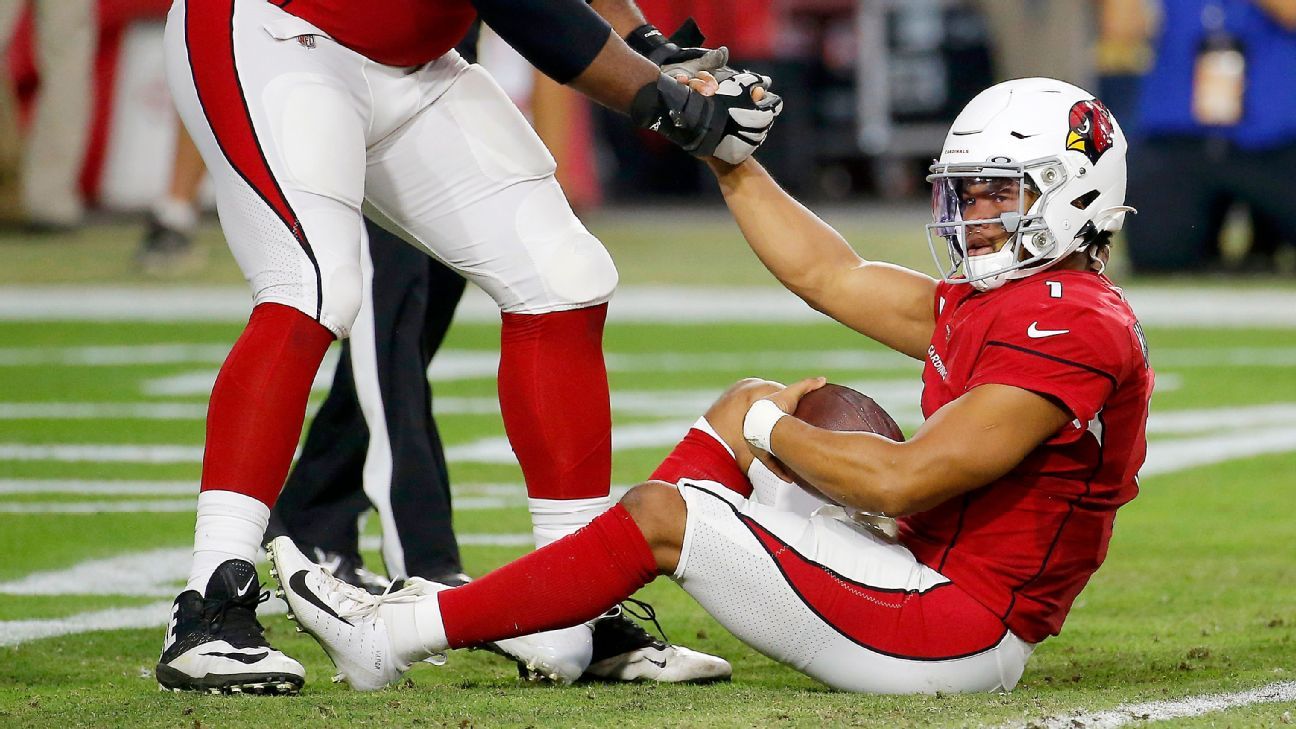
Welcome to the NFL, rookie.
Kyler Murray learned how the other half lives Thursday against the Raiders, who blitzed the No. 1 overall pick and made him look uncomfortable. But it wasn't all bad for the youngsters as Week 2 of the preseason started, with Dwayne Haskins showing off his arm with a big touchdown pass against the Bengals.
We have all that and more in the biggest takeaways and fantasy football nuggets of the preseason's second week from NFL Nation:
Jump to a matchup:
PHI-JAX | NYJ-ATL | CIN-WSH | GB-BAL | OAK-ARI
Philadelphia Eagles 24, Jacksonville Jaguars 10
Carson Wentz should not touch the field this preseason. The QB injuries are piling up for Philadelphia. Cody Kessler was knocked out of the game in the first quarter Thursday because of a concussion, one week after backup Nate Sudfeld went down because of a broken wrist. Coach Doug Pederson has been ratcheting up the intensity at practice to give the first team quality work in a controlled environment. He should continue on that path and keep Wentz out of harm's way until the regular-season opener against Washington. The Eagles will probably have to add another arm this week with Kessler in concussion protocol. -- Tim McManus
QB Gardner Minshew needed a bounce-back performance after really struggling in the preseason opener and he delivered: 19-for-29 for 202 yards in three quarters despite being under pressure from the edge pretty much the entire night. Minshew did lose a fumble after getting hit (RT Leonard Wester got beat badly) and also had a TD pass called back because of a block-in-the-back penalty by TE Ben Koyack. Minshew also put together a solid two-minute drive at the end of the first half that resulted in a field goal, giving the Jaguars their first points of the preseason. Minshew was clearly much more comfortable than he was last week. He was decisive and got the ball out quickly, which are encouraging signs for the Jaguars --- who again sat the majority of their starters -- because they're counting on him to be the backup to Nick Foles. His performance Thursday night pretty much cemented that. -- Mike DiRocco
New York Jets 22, Atlanta Falcons 10
0:29
Darnold leads Jets on TD drive
Sam Darnold links up with Quincy Enunwa and Robby Anderson before Ty Montgomery plunges in for a 1-yard TD run.
Playing behind a makeshift offensive line, QB Sam Darnold opened with a TD drive for the second straight week. The tempo was fast, and Darnold was in command. It's early, but he seems to have a firm grasp of the new offense. Big concern: RT Brandon Shell injured his knee in warm-ups, becoming the third offensive lineman to go down because of an injury. Chemistry will be an issue in Week 1. -- Rich Cimini
There has to be concern about the offensive line during Matt Ryan's first appearance this preseason. Ryan was sacked three times and threw under duress too much while completing 10 of 14 passes for 118 yards. Ryan absorbed some good hits, something you never want to see in the preseason. Right tackle Ty Sambrailo didn't look like a starter, and backup center Wes Schweitzer, among others, had some issues. The Falcons are playing without two injured players who were thought to be on track to start: left guard James Carpenter (quad) and rookie right tackle Kaleb McGary (heart procedure). Jamon Brown could start at left guard, and McGary, if healthy, should surpass the struggling Sambrailo at some point. -- Vaughn McClure
Cincinnati Bengals 23, Washington Redskins 13
Rookie Ryan Finley made a strong case to be Cincinnati's No. 2 quarterback this season. The fourth-round pick out of NC State followed up his preseason debut with another strong performance. Excluding a spike at the end of the first half, Finley was 20-of-25 passing for 150 yards and two touchdowns. The rookie steadied the Bengals after a start riddled with miscues. He led Cincinnati's second unit on a 12-play, 93-yard drive that took 7 minutes, 36 seconds off the clock in the first half. From there, the entire team found its rhythm, as the visitors scored 23 of the final 30 points. Halfway through the preseason, the rookie has completed 75% of his passes for 259 yards, three touchdowns and one interception. -- Ben Baby
The Redskins hoped the preseason would identify their No. 1 quarterback, but after two preseason games, that hasn't happened. Colt McCoy can't yet play because of issues with his leg, and Case Keenum has been ordinary in two starts. He's still adapting to the offense and getting in sync with his receivers, but being in a competition makes it tougher to build that chemistry. And rookie Dwayne Haskins shows more big-play potential -- as evidenced by his 55-yard touchdown pass to Robert Davis. He's not afraid to challenge down the field, but he also hasn't shown enough to seriously challenge more experienced players. But with what those players have shown, it's hard to believe Haskins won't be used at some point this season. -- John Keim
Baltimore Ravens 26, Green Bay Packers 13
It might be too soon to say the Packers have a serious problem with their run game -- after all, neither Aaron Jones nor Jamaal Williams (both have hamstring issues) have played a snap in the preseason -- but the installation of new coach Matt LaFleur's outside-zone-oriented scheme has been a rough go. The Packers totaled just 7 yards rushing on seven attempts in the first half a week after they had only 38 yards in 13 carries in the first half against the Texans. That's 45 yards in 20 carries when the opponents were playing starters or key backups. Any hope that sixth-round rookie Dexter Williams could serve as a change-of-pace back looks bleak given his inability to hang on to the ball (he dropped a pass and couldn't secure a handoff in which a fumble was charged to the quarterback). Tra Carson has been the starter in the absence of Jones and Jamaal Williams, but he's averaging just 1.7 yards per carry. As much as LaFleur's offense centers on the run game and what it can do for play-action, he needs to know if the lack of production is because he doesn't have his top backs or because the scheme hasn't taken hold. -- Rob Demovsky
0:34
Jackson hurdles defender for TD, called back on penalty
Lamar Jackson breaks free for an 18-yard touchdown, but it is nullified because of Willie Snead IV's illegal blindside block.
Lamar Jackson continues to improve as a passer, but -- as the Ravens' starting quarterback showed and said Thursday night -- he's still at his most dangerous when running with the ball. On third-and-10, Jackson saw his receivers covered and took off, faking out Tramon Williams in the open field before leaping over Jaire Alexander to reach the end zone. The spectacular 18-yard touchdown run was nullified by Willie Snead's illegal block, but that doesn't erase another highlight-reel moment that will keep defensive coordinators up at night. "The four-man rush gave me a lane," Jackson said, "and I just did what I do best." Jackson finished 6-of-10 passing for 58 yards, leading the Ravens to field goals on both of his drives. -- Jamison Hensley
Oakland Raiders 33, Arizona Cardinals 26
The Raiders' defense, with a cast of new characters headlined by middle linebacker Vontaze Burfict, looks much improved. At least it did in this second exhibition for both teams, with Oakland harassing No. 1 overall pick Kyler Murray into a 3-for-8 passing night for 12 yards, and defensive back Lamarcus Joyner sacking the nimble Murray for a safety. In four series, the Raiders' starting defense let Murray run only once -- for 4 yards. In fact, Joyner's safety came on the third straight blitz dialed up by defensive coordinator Paul Guenther. At one point, the Raiders had outgained the Cardinals 231-12 in total yards. Also, rookie Josh Jacobs looks primed to be the Raiders' feature back, starting and carrying the ball four times for 21 yards on their opening touchdown drive with Derek Carr under center, as the Raiders' starting offense played only one series. -- Paul Gutierrez
Thursday night was one to forget for Kyler Murray. The rookie quarterback went 3-for-8 for 12 yards with a 4-yard run and looked out of sync in the four possessions he played, which went into the second quarter. He was flagged twice for false starts because of his clap snap and once for delay of game, and went down in the end zone to avoid a sack for a safety. While, yes, it's still the preseason and the Cardinals are running a vanilla offensive scheme, there were still some issues Murray and the Cardinals need to clean up. -- Josh Weinfuss
Tagged under
Sources: Patterson, Clips agree to 1-year deal
Published in
Basketball
Thursday, 15 August 2019 15:26

Free-agent forward Patrick Patterson has agreed to a one-year, $2.3 million deal with the LA Clippers, league sources told ESPN.
Patterson and the Oklahoma City Thunder recently agreed to a buyout on the final season of his contract, allowing him to become a free agent.
The Clippers, with one available roster spot left now, are constructing a frontcourt bench to support its two new starting forwards -- Kawhi Leonard and Paul George. Patterson gives the Clippers, who are expected to contend for a championship, one more serious-minded and accomplished veteran for their frontcourt rotation.
Patterson, 30, was unable to gain consistent traction in a role with the Thunder in his two seasons there. He averaged less than 10 minutes a game -- far different from his impactful previous three seasons with the Toronto Raptors. In nine NBA seasons, Patterson has averaged nearly seven points and four rebounds. He's had stops with the Rockets, Kings, Raptors and Thunder.
Tagged under
Sources: Nets CEO out amid change in ownership
Published in
Basketball
Thursday, 15 August 2019 19:31
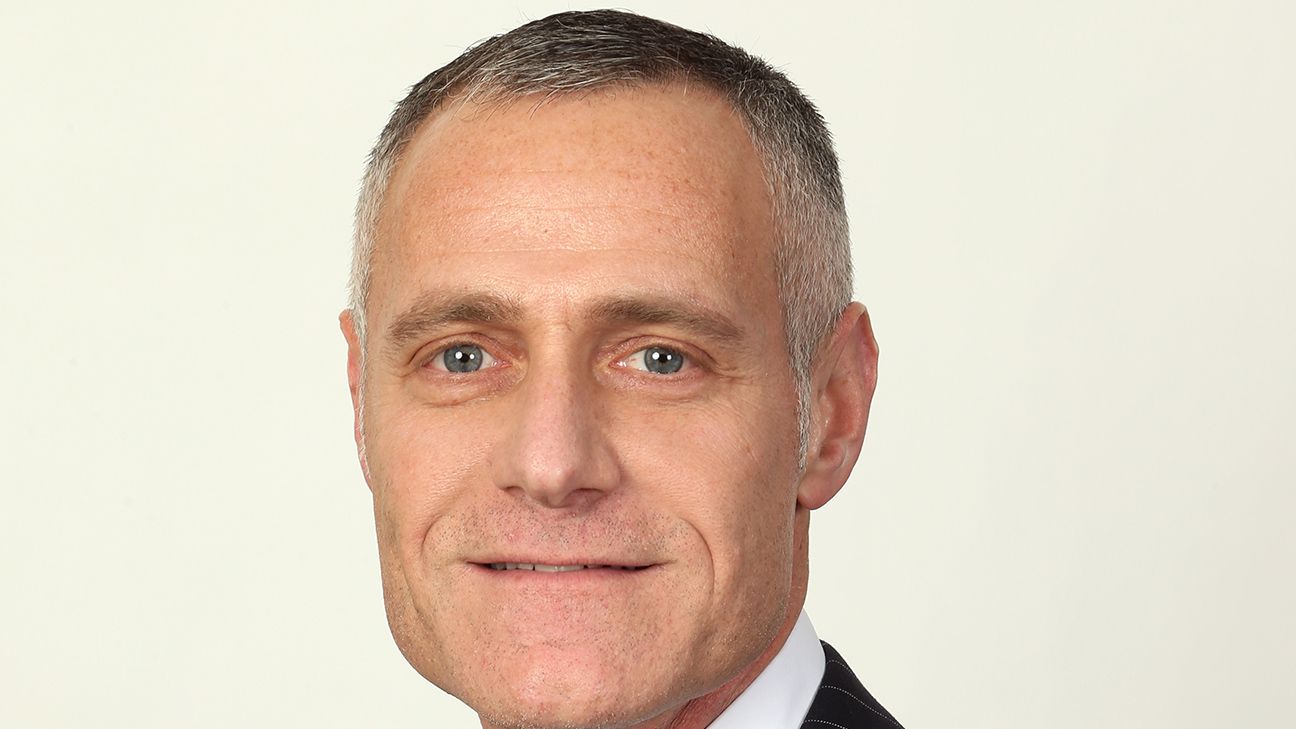
Brett Yormark, who has served as CEO of the Brooklyn Nets for more than a decade, will step down from his post, league sources confirmed to ESPN.
Yormark has been in the role since 2005, when he came to the Nets from NASCAR, and helped usher the franchise to Brooklyn from its prior homes in East Rutherford and Newark, New Jersey. Having initially come aboard under Bruce Ratner, Yormark stayed in his post during the ownership of Russian billionaire Mikhail Prokhorov over the past nine years.
But with Prokhorov set to sell the final 51% of the Nets -- and, eventually, Barclays Center -- to Joe Tsai, ending his tenure with the franchise, Yormark's time with the Nets is coming to a close as well.
Yormark -- like Prokhorov -- will be remembered for being part of getting the Nets across the Hudson River and into Brooklyn, a move that dramatically raised the profile of the franchise. He also was part of the team's brash, aggressive style early in its time in Brooklyn, an approach that led the Nets both to spend record amounts of luxury-tax money and to put the team in a massive hole in terms of draft capital lost thanks to the failed trade for Kevin Garnett and Paul Pierce in 2013.
The sale to Tsai, and the departure of Yormark, will see Brooklyn head into one of the most anticipated seasons in franchise history with a fresh slate.
The Nets made arguably the biggest splash of any team in the NBA this summer, signing Kevin Durant, Kyrie Irving and DeAndre Jordan as free agents after finishing a surprising sixth in the Eastern Conference last season and losing a spirited five-game series to the Philadelphia 76ers in the first round of the playoffs.
Tagged under
Cousins injury left Draymond 'at a loss for words'
Published in
Basketball
Thursday, 15 August 2019 17:08

EL SEGUNDO, Calif. -- Draymond Green had just told DeMarcus Cousins that he hadn't seen him look this fit and slim since his college days at Kentucky. He was ready to see the big man wreak havoc on the NBA this season.
That was just last week.
On Thursday, Green and the rest of the NBA learned that Cousins had suffered yet another crushing setback with a torn left ACL, leaving Green uncertain of what to say or text to his good friend and former Golden State Warriors teammate.
"One of my goals coming into this season was for DeMarcus to destroy everybody and come back and show how great of a player he is and get what I think he deserves," Green told The Undefeated's Marc Spears. "I'm really at a loss for words about it. It's one that really hurt me for sure."
Green stopped by USA Basketball's practice at the Los Angeles Lakers' facility on Thursday. News of Cousins' latest gut-wrenching setback spread quickly through the team practice.
"I'm devastated for DeMarcus," said Warriors coach Steve Kerr, who is an assistant for Team USA and coached Cousins last season with Golden State. "It's been a couple of years of hell for DeMarcus. ... We are all crushed for him."
"Injuries are a part of the game," Kerr later added. "But when you are talking about a player who has now dealt with the two most feared injuries for NBA players -- the Achilles and the ACL -- each basically knocking you out for an entire season ... to deal with that over a two-and-a-half-, three-year span, it's unheard of. What a blow for him, for the Lakers. He is going to have to process it all, start all over again."
USA forward P.J. Tucker said the Cousins news was "heartbreaking."
Green says that if anyone can overcome this series of injuries, it's Cousins.
"He made it out of Mobile, Alabama," Green said. "The NBA is tough, very tough to get to, very tough to stay in.
"But he made it out of Mobile, Alabama. If he can do that, he can do anything."
Tagged under
Bellinger hits NL-best 40th HR, but Dodgers fall
Published in
Baseball
Thursday, 15 August 2019 18:40

MIAMI -- The rout-filled Dodgers-Marlins season series ended Thursday afternoon, and look who's laughing now.
Last-place Miami turned the tables on NL West leader Los Angeles, winning 13-7 despite giving up four home runs, including Cody Bellinger's 40th.
"It wasn't a good day of pitching for us," Dodgers manager Dave Roberts said.
Despite the drubbing, the Dodgers increased their homer total this week at pitcher-friendly Marlins Park to 14, a franchise record for a three-game series. Max Muncy hit his 29th, Corey Seager his 12th and Kyle Garlick his third.
Bellinger, who began the day tied with Christian Yelich and Mike Trout for the major league lead, reached the 40 mark for the first time with a three-run shot into the upper deck in the seventh inning to cut the deficit to 13-7.
Trout hit his 40th homer later Thursday against the Chicago White Sox to match Bellinger.
Los Angeles had won the previous five games against Miami this year by a combined score of 45-9, including a margin of 33-2 in the past three games.
But the Marlins averted a three-game sweep and won the season's final matchup between the teams with the best and worst records in the National League.
"It feels good, man," said center fielder Lewis Brinson, who contributed three RBIs and a pivotal defensive play. "That's a good team over there. Their record and all their numbers show it. We just said we've got to fight every at-bat against these guys, because they're a good squad. That's exactly what we did."
The Marlins won without hitting a home run while totaling 13 hits and six walks.
"Obviously it took a lot of hits to get those runs, but that's who we are right now," manager Don Mattingly said.
Brinson, Brian Anderson, Starlin Castro and Jorge Alfaro each had three RBIs, and Jon Berti scored three times as the game literally became the latest laugher in the series. Castro wore a grin crossing the plate in the fifth to make it 7-1.
The last time Marlins had four players with three or more RBIs was in 2006.
Caleb Smith (8-6) needed 106 pitches to get through five innings but gave up only one hit and one run -- on Garlick's homer in the fifth.
Walker Buehler (10-3) gave up five runs in four-plus innings. It was a rare lapse for a rotation that entered the game with a 1.69 ERA this month.
"A breakdown of everything I do well," Buehler said. "Not a good one. Never fun to put our team in a situation like that."
The longest nine-inning game in the eight-year history of Marlins Park took 4 hours, 7 minutes.
Anderson drove in the game's first run with an RBI bloop single in the first. His two-run double in the fifth made it 4-0 and knocked Buehler out of the game.
The Marlins' first seven batters reached in the fifth, and six scored. Brinson's two-run double made it 8-1.
Brinson also charged to making a diving, inning-ending catch in center field to rob Seager of an RBI single in the fourth.
"Any runs you can take away from that team definitely feels good," Brinson said. "I don't know how I caught that ball, but it stayed in the glove."
MILESTONE
Bellinger became the first player in the majors to reach 40 homers this season. He hit 39 as a rookie in 2017.
"It's pretty cool," he said. "There's still a lot of baseball left to be played, so I'm going to keep doing what I'm doing, and hopefully more to come."
PUZZLING SPLITS
Buehler is 5-0 with a 2.33 ERA at home. On the road he's 5-3 with a 4.37 ERA.
"I'm trying to figure out what the difference is," Buehler said. "I felt good today. I just didn't put the ball where I wanted it."
TRAINER'S ROOM
Dodgers RF Kristopher Negron (nose and forehead bruises and abrasions) left the game when he did a face plant in a failed attempt to catch Brinson's double. Concussion tests and X-rays were negative.
UP NEXT
Dodgers: RHP Kenta Maeda (8-8, 4.12) is scheduled to start the opener of a three-game series at Atlanta on Friday. Maeda last faced the Braves in 2017 but has won both of his starts against them.
Marlins: A six-game trip begins Friday with All-Star RHP Sandy Alcantara (4-10, 4.44) scheduled to start at Colorado. In his past eight starts, Alcantara is 0-4 with a 7.29 ERA.
The Associated Press contributed to this report.
Tagged under















 Phone: (800) 737. 6040
Phone: (800) 737. 6040 Fax: (800) 825 5558
Fax: (800) 825 5558 Website:
Website:  Email:
Email: 






